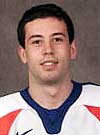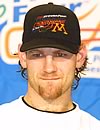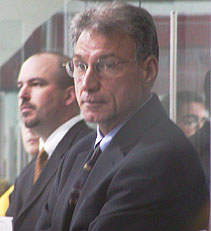Half of the ECAC teams have seen game action in the last three weeks. This weekend, it’s time for the other half to hit the ice with their editions of their 2002-2003 teams.
Itching To Get Going
The Ivies get underway with a slew of exhibition games this weekend, some with high expectations. The Cornell Big Red and the Harvard Crimson are among that group, voted 1-2 by both polls in the ECAC and moving up in the national polls despite not playing.
The Big Red open up on Sunday in an exhibition against York at Lynah Rink with those expectations.
“We had the same kind of expectations a year ago at this time,” said head coach Mike Schafer. “So from our standpoint from within the program, the expectation is that they have the same expectations, and that’s good. We kind of fulfilled them last year and we’re looking forward to this year.
“It’s a long time between games. Our guys are looking forward to starting again.”
The Big Red, as well as the other Ivies, have been officially practicing since October 15. After two weeks, you know that they are itching to get out there.
“The players have been working hard and this will be their first opportunity to show what they have accomplished during our preseason workouts,” Schafer said. “The players are in top physical shape, so that helps us jump right into things.”
The Crimson, meanwhile, open against Canadian school Guelph on Saturday and also face expectations coming off an ECAC championship.
“You can’t place a value on the experience gained from your squad playing in big, meaningful games, games where the stakes are different and there are tremendous consequences,” said head coach Mark Mazzoleni. “We have made progressive steps, and as a result, the stakes — and all of our expectations — are higher.”
Each year the Crimson have had the weight of expectation on their shoulders. Each year, everyone keeps expecting big things. This year, the Crimson could ascend even further.
“We have learned a lot about ourselves in the last few years,” said Mazzoleni. “We have gained maturity, in knowing exactly what type of effort it is going to take to achieve our goals. Having experienced the things we did last season — both the tough times and the satisfaction of winning the [ECAC] tournament — gives us some confidence and a bit of a mental edge.”
Let’s Not Forget…
Brown, Dartmouth, Princeton and Yale also get under way this weekend, all in exhibitions. There are some expectations here as well.
“The expectations are higher. I think that’s good and we welcome that,” said Brown head coach Roger Grillo. “It’s been the opposite the last couple of years. I told the guys that you won’t be able to sneak up on people, that you’ll have to work harder and that doesn’t make things easier. I welcome the challenge, as do all of us.”
“These guys have had success. They want the next step and they won’t settle for anything less,” said Dartmouth head coach Bob Gaudet, . “There are no excuses; we expect this squad to make a run for it. We may be quite a bit quicker than we were last year and I know we can do better than (ninth, as picked in the preseason poll).”
“If I project ourselves at the end of the season I see a lot of guys contributing,” said Princeton head coach Len Quesnelle. “Coming into this year we’ll be a little bit more competitive internally at all positions. I don’t think we have the clear go-to guy, at least not yet. I think that we’re going to have a number of guys contributing.”
And there are individual expectations for one of the league’s stars in Yale’s Chris Higgins.
“It’s always great to have such a talented offensive player in your arsenal,” said Yale head coach Tim Taylor. “He distinguished himself as an 18-year old freshman who has the ability to score at this level. He will be a year older and wiser, but his challenges will be greater because he will be a known quantity and will receive specific attention from all of our opponents. Hopefully we will have enough talented kids to take the focus off Chris.”
And they’re off.
Hey, Us Too
The Clarkson Golden Knights have been in action for two weekends, but in two exhibition games. The Knights go at it for real as they travel to Ohio State for a pair of games over three days.
“We’ve played a couple of exhibition games now that have given us a chance to fine-tune our game,” said head coach Mark Morris. “The University of Toronto game was a wide-open offensive affair. The U.S. National Under-18 team came in and played us extremely tough. Their goaltender played very well. For the most part we played a pretty sound game ourselves. We have jockeyed some line combinations and hopefully for this upcoming series against Ohio State we will have a pretty good read on what works and what doesn’t.”
“I expect it will be a real competitive weekend for us. It will be a good tuneup as we head into our league opener at St. Lawrence.” That game happens Nov. 2.
A Recap
It wasn’t a good weekend for the ECAC on the scoreboard. The league went 1-5-2 in games, with the lone win coming from Union, 5-2 over Niagara. Hopefully for the conference, this weekend will bring better results.
Is Home Actually Better?
We’ve had the opportunity to watch a couple of games now with the new 15-second faceoff rule and while there are definitely advantages, there is one major problem that we can see.
The new rule takes away some of the edge of being the home team. While each team has five seconds to get their personnel on the ice, in reality the road team actually gets more time to put their line out. The road team has the advantage of the time between the whistle until their turn is up, whereas the home team only has five seconds.
In fact, one coach has realized this already, and in one recent game where a coin toss gave one team the choice to be the home or road team, the team that won the toss decided to be the road team. Why? Because of the new faceoff rule.
Will there be a change? Expect it to be addressed during the spring meetings.
There Is Justice
Last week we told you the plight of Colgate and the Maverick Stampede with the unauthorized second overtime. Well, justice is now done, as the game result has officially been changed by the NCAA ice hockey committee.
The game will be reflected as a tie for Colgate and Nebraska-Omaha rather than a win for UNO and a loss for Colgate. All events after the first overtime are now null and void.
This means that Scott Turner’s goal in double overtime will no longer count. That’s the case with all statistics after the 65-minute mark.
Colgate now has a tie, and a 0-2-1 record. Nebraska-Omaha is now 1-2-1 instead of 2-2-0.
Sometimes the world is okay.
Huh?
What would have happened if we were picking the ECAC Honorees this week? Not to take anything away from the accomplishments of those named, but we would have went this way:
ECAC Player of the Week: Kris Goodjohn, Union
ECAC Rookie of the Week: Kris Mayotte, Union
ECAC Goaltender of the Week: Shawn Conschafter, Vermont
Guess What?
Some things we’d just like to throw out there.
Guess who’s third in points per game in the NHL?
Martin St. Louis.
Guess who scored the first goal in Cape Fear FireAntz (ACHL) franchise history last weekend?
Chris Migliore.
As of Tuesday, guess who was leading the ECHL in scoring — well, tied for it?
Scott Bertoli.
Thought you folks should know.
A Loss
Our condolences go out to the family of Clarkson All-American goaltender Terry Yurkiewicz, who passed away earlier this month in Arizona.
Yurkiewicz was named All-America in 1965 and 1966 and was one of the leaders of Clarkson’s first ECAC championship team in 1966, earning the tournament MVP Award. He was 43-10 in his career with a .910 save percentage and a 2.10 GAA.
The Best and Worst
We’re back with another edition of the best and the worst.
The Best — The Union Dutchmen
The Dutchmen were the only ECAC team to register an official win last weekend, thanks to great efforts from all involved. They get the nod this week.
The Worst — The Record
The ECAC went 1-5-2. “Ugh” is all we have to say.


